Editing your profile¶
Let’s take a look through how to get started editing a profile.
In general, there are two key types of information on the Research Portfolio:
Self-contributed information: particulars that you can update online any time via your profile page, such as biography, interests and experience. Changes take effect immediately and are visible instantly.
See Changing self-contributed information for more details on how to edit this data.
Institutional information: data that other departments are responsible for managing, such as publications, research grants, and personal information. Updates will be automatically reflected on Portfolio pages on the weekend following a change.
You’ll need to contact the relevant department to update this data.
Who can edit profiles?¶
Individuals can edit their own profiles online, and anyone who holds the Research Portfolio Officer organisational role may edit profiles within their College or Discipline. To determine who may edit profiles in your department, see role emails.
Editor’s view¶
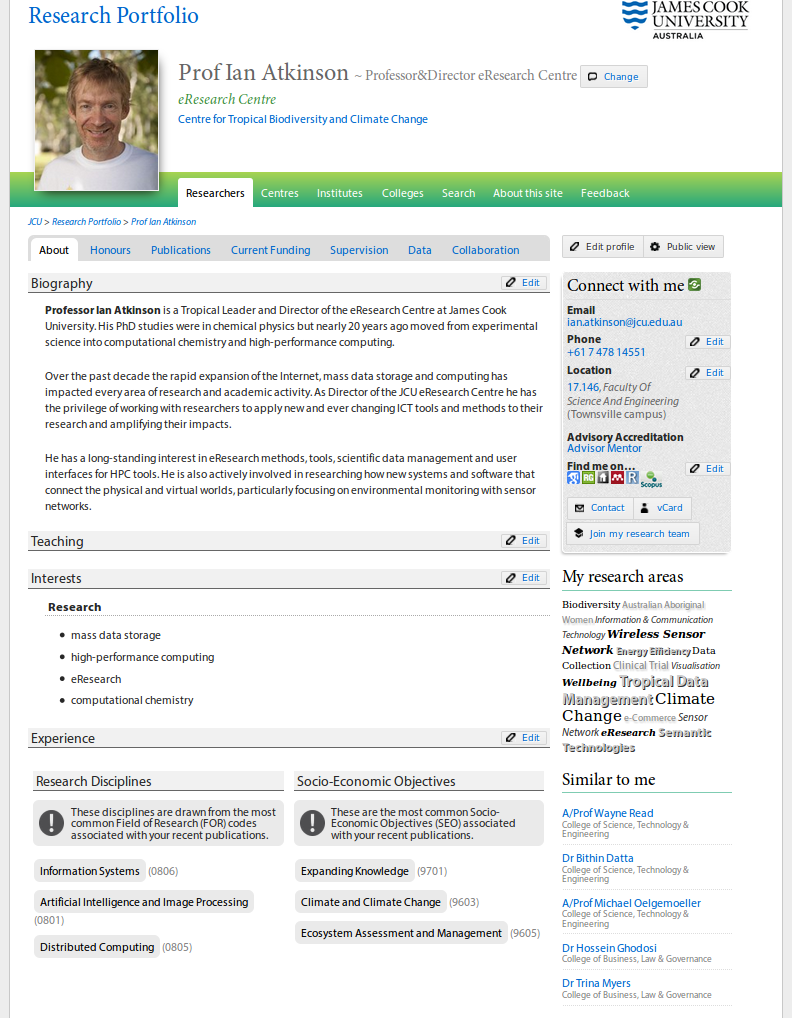
If you’re logged in and viewing your own profile or a profile that you can otherwise edit, you’ll notice the page will show all potential data tabs and a number of Edit buttons on the page. This shows a complete view of what can be included and how to update details or who to contact.
Viewing your updated profile¶
Note
If your profile is hidden, it will not be listed anywhere on the site. Anyone without edit access will not be able to see or access your profile.
If you’ve just updated settings or information on your profile, you’ll want to see how it looks to the world.

- If still editing your profile, click the
Cancel editingbutton on the Edit profile page. - Click the
Public viewbutton to toggle how your profile appears. Any empty tabs or sections will disappear. - Click the
Public viewbutton again to toggle the page back again.
Changing self-contributed information¶
All these tasks will require you to first login and access your profile page. If you are a Research Portfolio Officer and editing others’ pages, you’ll need login as yourself, but you’ll be accessing the researchers’ pages.
Adding or changing photos¶
Note
Try to select an image with eye contact that helps identify you! The University style guide sets out that our imagery is full colour, bright and high in contrast with saturated colours, so select an image like this.

To update your existing photo or change the initial generic photo:
Login and access your profile page.
Click the default photo on the profile page. You’ll notice an
Edit Photolabel appear when doing this.Use the pop-up window that appears to manage your photo.
Choose a photo to upload, and click the
Uploadbutton.Click and drag on the photo that is displayed to crop to suitable size.
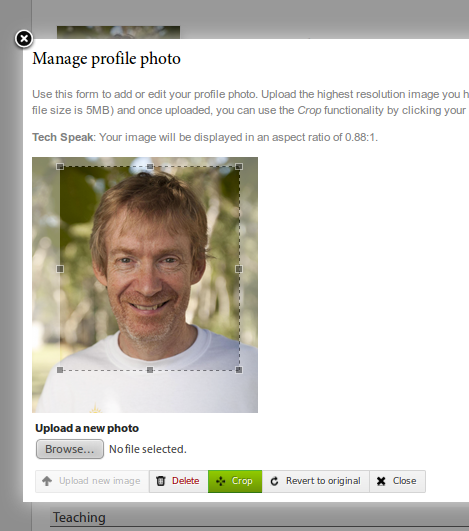
When done, click the
Cropbutton at the bottom of the page. If you make a mistake, you can clickRevert to originalto go back to the original image.Close the pop-up window to see the results.
Changing your profile settings and data¶
Note
Keep in mind that any changes to a profile will take time to be reflected in search engines. This may be several days or longer.
Aside from data sourced automatically, a profile page includes many types of information that you can update live online. To do so:
- Login and access your profile page.
- Click the
Edit profilebutton. - Step through each section of the form and add details or change settings.
- Click
Save changesto update your profile. Changes will be applied immediately.
Types of information you can self-contribute includes:
General settings¶
These are general configuration options that control how your profile is displayed on the site.
- Hide my profile
- Temporarily hide your profile from being public.
- Hide my title
- Hide your salutation/prefix from profile pages and listings.
- Hide Altmetric badges
- Hide the colourful Altmetric badges from publications.
Biography¶
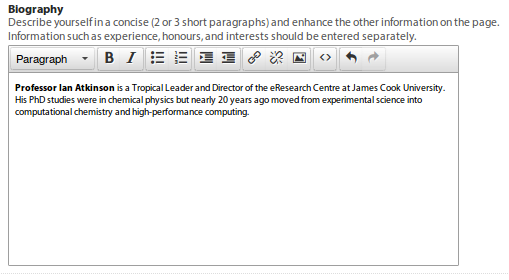
Your self-authored description of yourself, your research and other relevant details. The editor allows you to format text in multiple ways, insert hyperlinks and change the paragraph styles easily. The editor displays the results before you save the changes.
You can copy and paste from another document or your homepage, but please keep the biography concise - two or three short paragraphs - so it doesn’t overshadow the other information on the page. Ensure you break out your experience, honours and interests into the appropriate sections as this will improve your search rankings.
You are able to add links, bulleted or numbered lists and images into your biography but these should be used carefully and sparingly. Remember that this is the world’s view to you and your research.
Experience¶

Describe positions and experience relevant to your work by adding them, one at
a time. For a current position, leave the End Year field empty.
Note
Experience is shown in reverse chronological order when displayed on a profile page.
External identifiers¶
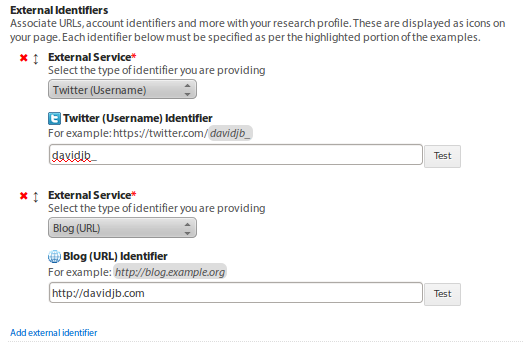
These are links to your website, web pages or profiles on systems external to the University that help to bridge your digital identity. These can be publisher or professional identities such as ORCID, Scopus or Google Scholar and can also be social media sites such as LinkedIn and Twitter. When you enter and save an identifier, the corresponding icon will appear on the Connect with me panel on your profile.
When adding a new identifier, the grey highlighted section of the example
(sometimes the example is the entire entry) shows the part of the URL or
identifier required. You can use the Test button to confirm your profile
loads in the pop-up window that appears.
If you’re editing your profile for the first time, you’ll likely find some of these identifiers have been added automatically.
Note
Identifiers are shown in the order you list them when displayed on a profile page.
Honours¶
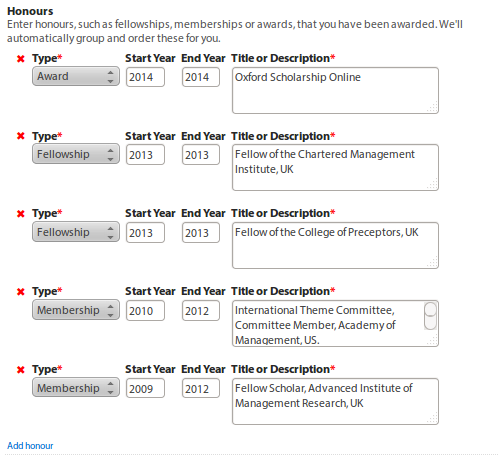
Highlight fellowships, memberships and awards that you’ve received or are associated with by adding Honours to your profile.
Note
Honours are grouped by type, and shown in reverse chronological order when displayed on a profile page.
Interests¶

Describe topics you are interested in within a research, teaching or professional capacity. All information is searchable across the site, and can improve your discoverability.
Note
Interests are grouped by type, and shown in the order you list them when displayed on a profile page.
Locations¶

Add rooms or lab locations to your profile. Adding a location automatically links to interactive maps to display your building.
Note
Room locations are only available for Townsville and Cairns campuses at present.
An auto-completion list will be displayed when entering a building number. Use this to select your room from the menu. You can add a second room, such as if you have an office on a different campus or lab in a different area.
Note
Locations are shown in the order you list them when displayed on a profile page.
Updating institutional information¶
Beyond the self-contributed information mentioned above, the Research Portfolio uses information from the following James Cook University systems:
- Human Resources Information Management System (HRIMS)
- JCU Identity Management (ICT)
- Telephone Switchboard (Operators Database)
- Research Information Management System (RIMS; Research Services)
- ResearchOnline@JCU (JCU Library)
- Student Management System, StudentOne (GRS)
- Research Data Catalogue (ReDBox; Information Services)
- Teaching Roles Database (TRDB)
As the Research Portfolio is acts as a display of information from these other systems, the original department managing the data is responsible should it need correction. Any changes will automatically flow through to the Research Portfolio; see recent changes.
Note
Before contacting the administrator of any data source please check the criteria and notes listed to ensure that the data in question is indeed incorrect and not just excluded from display.
Human Resources Information Management System (HRIMS)¶
- Title (except for the title of Distinguished Professor, which are managed in Research Information Management System (RIMS; Research Services))
- Name
- Position title
- Organisational units
- Campus (used only if the Telephone Switchboard hasn’t recorded your campus)
Note
The basic information about each researcher displayed in the titles, headings and Connect with me panel.
For changes, contact Human Resources by submitting a request through the HR Service Catalog. From this landing page, click onto HR Services and follow the guide to submit the type of request that matches your change. Most requests will either be Employee Information Changes or General Enquiries.
For corrections or changes to the above-listed information, verification will be required, usually with supporting documentation. For example, a copy of your qualifications would be required to change your title or an official document required to change your name. Your email address can be changed after a change of name is firstly confirmed by Human Resources.
Campus information is only used from Human Resources as a fallback if the Telephone Switchboard (Operators Database) has no location present. Put simply, the easiest option to update your campus is to make requests to both HR and to the Switchboard.
Updates will be automatically reflected on Portfolio pages on the weekend following a change.
JCU Identity Management (ICT)¶
- Email address
For changes, contact the IT Helpdesk. Correct information must already be in the HRIMS system. For example, if you require your preferred name to be used in your email address rather than your given name, then the preferred name must already be in your Human Resources record.
Updates will be automatically reflected on Portfolio pages on the weekend following a change.
Telephone Switchboard (Operators Database)¶
- Phone numbers
- Campus (if empty, your campus is obtained from HR)
Note
Displayed in the Connect with me panel, if available.
For changes, log an IT Helpdesk request asking for your staff contact list telephone number to be updated. Alternatively, you can request changes be made by calling the JCU Switchboard directly; hold the line until you reach a Switchboard operator and then ask them to update your staff contact list telephone number.
Campus information from the Switchboard is used as the primary data source but the Research Portfolio will use data from Human Resources if no location is present here. Put simply, the easiest option to update your campus is to make requests to both HR and to the Switchboard.
Updates will be automatically reflected on Portfolio pages on the weekend following a change.
Research Information Management System (RIMS; Research Services)¶
- Title (Distinguished Professor title only)
- Preferred name (preferred form of first name)
- FOR codes
- SEO codes
- Keywords
- Collaborations (co-investigators from funding and co-authors from research outputs)
- Funding details (all current grants and those that finished in the last 3 years)
- Groups
For changes to these details, contact the IT Helpdesk and request the job be assigned to the Research Information team within Research Services. Updates will be automatically reflected on Portfolio pages on the weekend following a change.
Note
Preferred name is initially set as your first name from HR but remains separate such that a portfolio page can display a preferred form for your first name. For example, if your first name in HR is James and you prefer to be called Jim, contact Research Information to enact this change.
Note
RIMS combines data associated with publications and grants/contracts, for the last five years, to produce:
- Top Research Disciplines
- Top Socio-Economic Objectives (SEO)
- A set of most frequently used keywords for research activities
- List of current funding. Includes those granted but not yet started; currently active; or completed in the last year.
- Collaboration world map, by country and state for Australia, USA, and Canada. Collaborations are per institution.
Codes, keywords and collaborations are based on data entered into ResearchOnline@JCU for outputs and into the RIMS Grants database for inputs over the last 5 years. Submitting publications and grants will automatically update the codes, keywords and collaborations displayed.
ResearchOnline@JCU (JCU Library)¶
- Publications
Note
Publications are grouped by type, and the 12 most recent publications are shown. HERDC eligible outputs are favoured over others, even if they are older. As such, if you have more than 12 recent publications, it is likely some more recent publications may not be shown. A visitor to a Research Portfolio page can always load the full list of publications by following the relevant link.
To submit publications, go to ResearchOnline@JCU. For importing your past outputs via ResearcherID and for changes to existing publications, output references, contact the ResearchOnline@JCU team.
The following summarises the types of publications that are considered HERDC-eligible and thus show on a Research Portfolio page:
| Publication Type | Description | Category |
|---|---|---|
| Book | Authored - research | A1 |
| Book Chapter | Chapter in A1 book | B1 |
| Journal Article | Refereed article in a scholarly journal | C1 |
| Conference Publication | Full written paper - refereed | E1 |
If there is a discrepancy, contact ResearchOnline@JCU staff to have the publication checked. If a publication type is not listed above, such as a thesis or technical document, then it won’t be shown on the Research Portfolio.
Updates will be automatically reflected on Portfolio pages on the weekend following a change.
Student Management System, StudentOne (GRS)¶
- Supervision records
Note
Supervision activities marked as currently active or completed within the last five years. For completed students, the thesis title will link to their ResearchOnline@JCU publication.
For changes, contact the Graduate Research School. Updates will be automatically reflected on Portfolio pages on the weekend following a change.
Research Data Catalogue (ReDBox; Information Services)¶
- Dataset records
Note
Displays the 10 most recently entered metadata records.
For updates or changes, manage this information directly through the ReDBox application. For more information, contact the IT Helpdesk and request the job be assigned to the Research Data team within Information Services.
Updates will be automatically reflected on Portfolio pages on the weekend following a change.
Teaching Roles Database (TRDB)¶
- Teaching commitments
Note
Displays only those subjects for which the researcher has Lecturer responsibilities in the current year. Subjects with the word Honours in the title are excluded.
For changes, contact the Teaching Role Administrator for your College or Division. To identify who to contact, use the role emails page.
Updating JCU search¶
JCU Research Portfolio pages automatically appear as part of the JCU website’s search results, displaying your name, photo and brief description when someone searches for a name or matching keywords.
The JCU search index automatically crawls all Research Portfolio pages on a nightly basis, and the JCU search webpage will periodically update its cache of the search index.
If search results for a Research Portfolio profile haven’t updated after 48 hours, please log an IT Helpdesk job, mentioning that your request should be directed to JCU Marketing and include the search URL that you have been looking at, as well as the expected result.